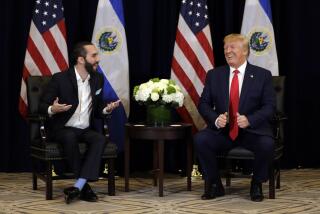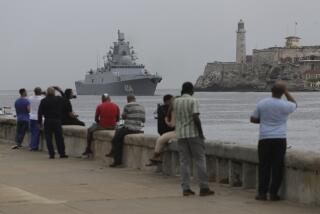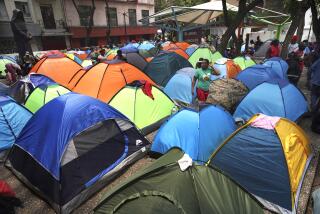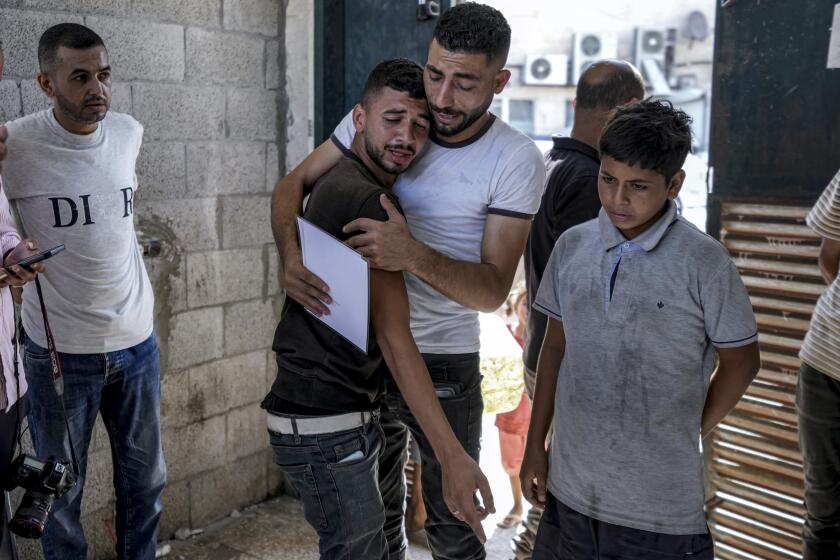COLUMN ONE : Miami Has Wary Eye on Castro : The refugee crisis shows again that the Cuban community has not escaped his shadow. Tightening of U.S. policy sparks hope, fear and confusion as city awaits his next move.
MIAMI — They rightly talk here about the talcum-soft sand of the endless beachfront and the creamy-colored buildings that line the boulevards like so many multitiered birthday cakes. Hurricanes have come ashore dead-on, flattening huge neighborhoods in a single hour of bluster.
But nothing--not the landscape nor the architecture nor the natural disasters--has shaped the character of this city more than a bearded old buzzard who has not set foot here in 40 years.
Miami is Fidel Castro’s communist revolution turned inside out, the capital of a Cuban diaspora that has managed to turn a dowdy, one-season tourist town into a U.S. gateway for Latin American profit-making.
Miami and Havana stare at each other across the Florida Straits--Cubans here, Cubans there--one heart with two opposing brains. As if in some bizarre time warp, the Cold War lives on in the moist, subtropical air.
Rarely has this been more true than in the past two weeks. Castro has once again opened the exits for his disenchanted, allowing thousands to flee the island in makeshift vessels. Some of the tiny craft are no more than a wooden plank atop two inner tubes strung together with twine. The impromptu sailors aboard them have come to be called balseros , or the rafters.
Their haphazard crossing presents too chaotic an exodus for America’s orderly immigration policy. This is very much as Castro wants it. For a generation, the United States has tried to choke his revolution with a trade embargo. He owes Uncle Sam no favors.
In the resulting havoc, President Clinton has issued an extraordinary decree. Arriving Cubans will no longer enjoy the special status that long has given them automatic asylum. In fact, the U.S. Coast Guard now intercepts the balseros and delivers them to Guantanamo, the U.S. naval base in Cuba.
Clinton’s decision is a source of trauma and confusion for the 560,000 Cuban Americans in Miami, so ready to welcome their freedom-seeking brethren, so cautious about the tricks of a wily nemesis that many here mythologize.
“Wait and see, Castro will outsmart Clinton,” said Rafael Penalver, a Miami attorney and Cuban activist. “This has all been a Castro show designed to get Clinton to the negotiating table and toss Fidel a lifeline.
“Within a few weeks, Castro will announce some meaningless elections. It will tempt Clinton with a chance to look tough and claim a victory, as if he stopped the exodus and led Cuba down the path to democracy.”
There’s no evidence to support such a theory, but this grand theme of a sly, all-powerful Fidel recurs here always, constant as the palm fronds and the palmetto bugs. Castro, the evil genius. Castro, history’s great survivor.
It is presumed that U.S. presidents are no match for him. The inexperienced John F. Kennedy is still blamed for failing to support a refugee brigade with air power during the Bay of Pigs invasion in 1961. For a time, Ronald Reagan was singularly thought to be Fidel’s equal. Cubans here called him El Machaso-- the great macho. But Reagan came and went and Castro remained.
So what is crafty Fidel up to this time, with the balseros ? Cubans here do not want a repeat of 1980. Back then, Castro opened the Mariel harbor. Miami’s exiles rushed over there in boats, ferrying some 125,000 new refugees away in a ragtag armada of skiffs, racing sloops, sailboats and shrimpers.
In the simplicity of that exultant spring, the armada was called the “freedom flotilla.” In a flurry of affection, the refugees were dubbed the Marielitos .
But, slowly, Castro’s trick became apparent. Along with the poor, huddled masses he had sent a few thousand criminals. The poor needed schools, shelter and medical care. The criminals required guns, drugs and victims.
Miami’s earlier Cubans had come to pride themselves on their up-by-the-bootstraps prosperity. They had been model citizens. Suddenly, with the Marielitos , Miami was the host city to an en masse Cuban prison break.
“The people from Mariel were also generally darker-skinned and not so well-dressed and not so well-educated,” said Arturo Villar, who does market studies specializing in Cuba. “There was a negative reaction.”
The endearing term Marielito was soon used as a slur. So, these past few weeks, with hundreds of Cubans arriving on rafts, local concerns were obvious. How many balseros were coming? And just who was it that Fidel was sending?
As these latest refugees were plucked from the sea, it was hard to greet them with anything but admiration. They had cast their fates to the Gulf Stream in perilous journeys that had taken one to 10 days. They emerged gaunt and sun-dried, their skin cracked with sores and burns. They looked like human salt sticks, their bodies stiff from hanging on as they bobbed.
One 8-year-old boy, Daniel Bussot, was rescued alone, clinging to a piece of wood. A squall had swamped his boat just after his mother gave him the only life jacket aboard. His parents died in the cruel pitch of the waves. “I hollered for my mom and dad, and they didn’t turn up,” he said.
Adis Sedeno, a 22-year-old mother, told a common story after seven days at sea. “Imagine what it is like now in Cuba,” she said of the reasons for risking her life. “Medical care, clothing, food--there is nothing there. There is nothing of everything.”
In her arms was her 1-year-old, Gustavo Antonio, his buttocks blistered with sunburn. “There were 29 of us, seven of them children. We had to breathe the fumes from the motor. Everyone was vomiting all the time.”
Jeremias Rangel, 24, set out with nine others. It was their seventh attempt to leave. On earlier tries, their rafts broke apart in the surf. Eventually, they launched from a swampy, mosquito-infested spit of coastline. Rangel’s wife was left behind. He thought she should wait for a better boat.
Now, under Clinton’s new policy, it is unclear if she can ever come to America. He phoned her from a friend’s house, west of Miami. Her father answered. “Forgive me for leaving her,” pleaded Rangel, a tall, angular man with a sharp chin.
His wife got on. “I’ll do anything to get there,” she said in sobs.
“No, don’t jump on just any boat!”
“I will!”
“No, if God wills it, we’ll see each other soon.”
The connection was impossibly bad. The phone clicked silent after three minutes.
With the telling of each remarkable, wrenching tale, the complicated feelings of Miami’s Cubans grow ever more addled. One emotion leapfrogs another.
Many of the more recent arrivals, such as the Marielitos , demand outright acceptance of the balseros , the more the merrier. They are likelier to have relatives among the rafters.
Some Cubans, on the other hand, suggest it is better for the balseros to stay on the island. They say that if the end of Castro’s 35-year-old regime is in sight, the disaffected could speed his downfall as foot soldiers in a counterrevolution.
“Of course, that is an immoral position, easy to propose by Cubans here who are comfortable and well-fed,” said Maria Christina Herrera, an outspoken college professor in Miami. “Let them live there and say it.”
By the nose-counting of pollsters, the majority of Miami residents agree with Clinton’s new Cuban refugee policy. It has the support of city and state officials, as well as the benediction of the Cuban American National Foundation, a powerful lobbying group whose chairman, Jorge Mas Canosa, has commended himself as a fitting successor to Fidel.
Nevertheless, nearly all Cubans blanch at the idea of fugitives from Castro being held behind barbed wire in U.S. custody. Some balseros have already been taken to the Krome Detention Center, at the edge of the Everglades. They were photographed in familiar orange jumpsuits as protesters rallied at the gate. Thousands of others will doubtlessly end up at Guantanamo.
This kind of treatment most commonly has been observed here with Haitian refugees, themselves desperate, impoverished boat people, nearly 15,000 of whom have been amassed at Guantanamo since July 5. Last week, mobs of the frustrated detainees pelted their U.S. guards with rocks and bed frames.
The Haitians’ dilemma has never been a great passion of Miami’s Cubans. In fact, the idea of the two refugee groups detained together summons some deep prejudices. “We don’t want our people in Guantanamo with a bunch of Haitians who are full of AIDS,” said Juan Lopez, 23, who came on the Mariel boat lift.
Oddly enough, the mingling of the two refugee groups also has provided Cuban Americans with a kind of middle ground, a way to agree with the President’s new policy and to condemn it at the same time.
“If Clinton wants to treat Cubans like Haitians, then let’s equate the entire situation,” said Julio Sanchez, a truck driver. “He should get the United Nations to blockade Cuba, just like with Haiti, and he should threaten to invade unless Castro steps down.”
That sentiment has been repeated time and again at small demonstrations around the city. A petition is being circulated along Calle Ocho, the main street through the neighborhood known as Little Havana. Protesters gather near a memorial for those refugees killed at the Bay of Pigs.
On some handmade signs, the ‘C’ in Clinton is represented with a hammer and sickle. Hunger strikers have forsworn any sustenance but cigarettes and Cuban coffee. Children chant, “ Cuba si, Castro no !” A woman with a candle strays down the street and lights it before a statue of the Blessed Mother.
Every so often, the crowd of 75 blocks traffic for five minutes or so. Drivers do not seem to mind. “We are all balseros ,” one of them, Julio Cesar, said with considerable statesmanship, as if announcing: “Ich bin ein Berliner. “
Once, late in the day, the crowd began to argue about which flag--America’s or Cuba’s--ought to be flown higher. It was an interesting question.
“I’ll tell you this,” said Manuel Coll, at age 60 a pot-bellied, overheated man. “If Clinton gets rid of Castro, I guarantee you that Miami will turn American again. We Cubans will all go back.”
Actually, surveys show that only 5% to 10% would return for good. Cuban roots have sunk deep in Miami. A generation has grown up with memories of Super Bowls and Bruce Springsteen and suburban malls.
In the old days, Havana had been like Miami’s older half-brother, a place of rumbas and rum, gambling and sin, where a guy like Sky Masterson could bring a doll for a torrid weekend.
Today, Havana is austere, hungry, wanting: a pitiable, woebegone relative. Miami is flush and glamorous, with foreign tourists poking their toes in the ocean and fashion models posing under the street lamps.
Latinos are in the majority here, with the percentage going up. Slightly more than half of the nation’s Cuban Americans live in greater Miami, according to Thomas Boswell, a geographer at the University of Miami. Cuban Americans make up 39% of the city’s population of 350,000, according to the 1990 census.
Other Latinos flock here as well. There are 74,000 Nicaraguans, 69,000 Puerto Ricans, 54,000 Colombians, 23,000 Dominicans, 23,000 Mexicans. Of late, these other groups have been arriving the fastest. In 1970, 83% of Dade County’s Latino population was Cuban; in 1990, it was 59%.
But it is the Cuban Americans who wield the power, in business and culture and politics. They have three representatives in Congress.
Well-established now, their community has had time to mature. A younger generation is not as scarred by exile, as torn between worlds.
Extremism in the defense of libertad is now a vice. Moderation has begun to emerge. It is even possible to urge negotiations with Castro without fear of violent reprisal.
“There are so few communist countries left, and the U.S. has come to terms with the others, why not Cuba?” said Herrera.
Six years ago, her home was bombed after she made similar statements. Such intolerance was once the practice. In 1976, a car bomb blew off the legs of popular radio newscaster Emilio Milian. He had dared to criticize anti-Castro terrorist bombings that had swept the city.
In 1979, and again in 1982, bombs blasted through the walls of a cigar factory owned by Orlando Padron, who had earlier visited Cuba to negotiate the release of political prisoners. The cigar maker was photographed handing a stogie to Castro.
Such memories seem somehow distant now, from some blurry time when communism was fully potent and red predators appeared to be nibbling at the globe.
There are still limits, however. And there always will be as long as Castro stays in power. In April, Miami lawyer Magda Montiel Davis went to Havana, attending a three-day conference called Emigration and the Nation. On a widely circulated videotape, she is shown at a reception greeting Castro with a kiss on the cheek.
Afterward, back here, her life was threatened. Crowds gathered outside her home in protest. Six secretaries at her firm--all Latinas--quit in protest.
Some things remain unforgivable, like kissing that demon Fidel, the face that launched a thousand rafts.
More to Read
Sign up for Essential California
The most important California stories and recommendations in your inbox every morning.
You may occasionally receive promotional content from the Los Angeles Times.









